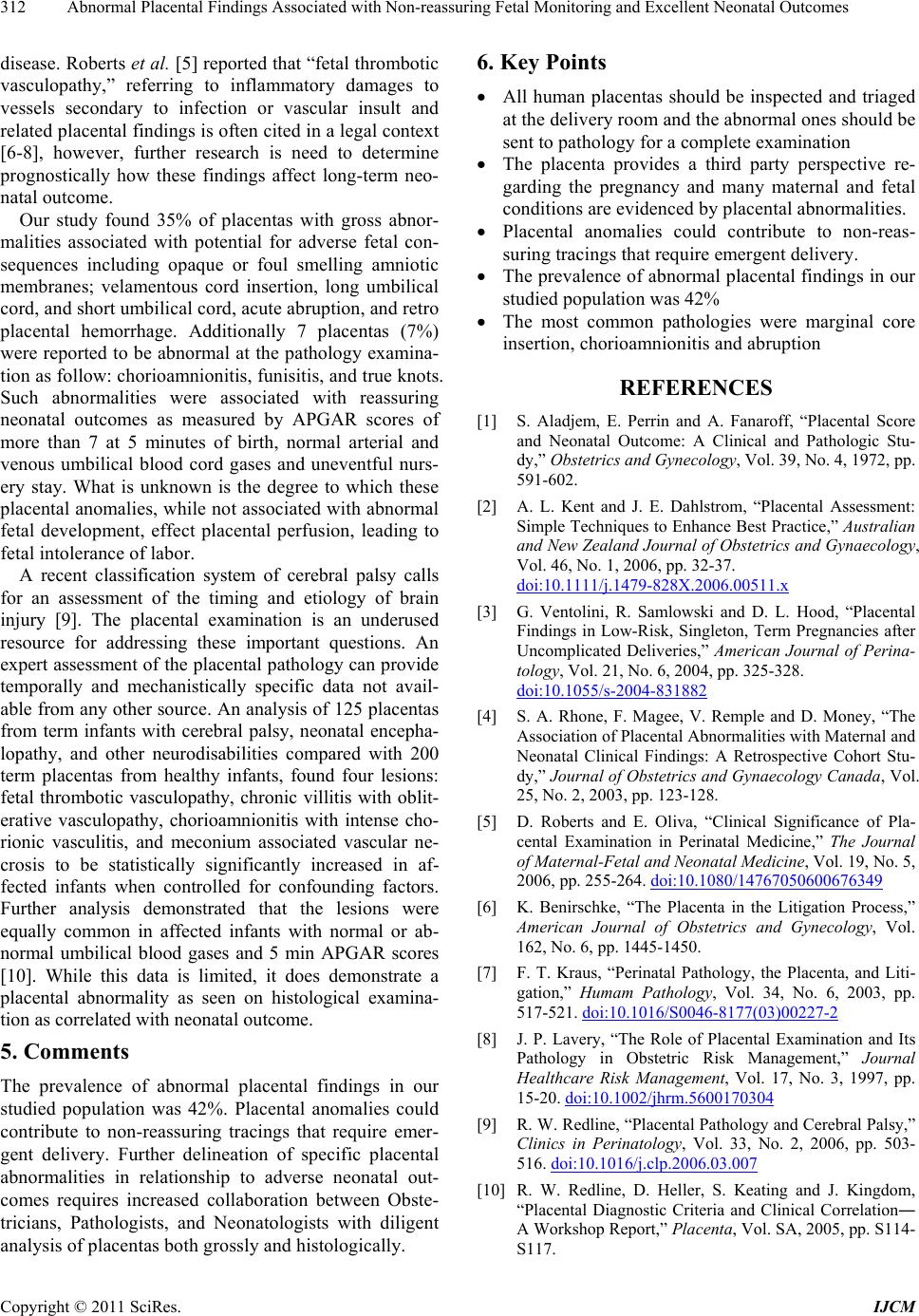
Abnormal Placental Findings Associated with Non-reassuring Fetal Monitoring and Excellent Neonatal Outcomes
Copyright © 2011 SciRes. IJCM
312
disease. Roberts et al. [5] reported that “fetal thrombotic
vasculopathy,” referring to inflammatory damages to
vessels secondary to infection or vascular insult and
related placental findings is often cited in a legal context
[6-8], however, further research is need to determine
prognostically how these findings affect long-term neo-
natal outcome.
Our study found 35% of placentas with gross abnor-
malities associated with potential for adverse fetal con-
sequences including opaque or foul smelling amniotic
membranes; velamentous cord insertion, long umbilical
cord, and short umbilical cord, acute abruption, and retro
placental hemorrhage. Additionally 7 placentas (7%)
were reported to be abnormal at the pathology examina-
tion as follow: chorioamnionitis, funisitis, and true knots.
Such abnormalities were associated with reassuring
neonatal outcomes as measured by APGAR scores of
more than 7 at 5 minutes of birth, normal arterial and
venous umbilical blood cord gases and uneventful nurs-
ery stay. What is unknown is the degree to which these
placental anomalies, while not associated with abnormal
fetal development, effect placental perfusion, leading to
fetal intolerance of labor.
A recent classification system of cerebral palsy calls
for an assessment of the timing and etiology of brain
injury [9]. The placental examination is an underused
resource for addressing these important questions. An
expert assessment of the placental pathology can provide
temporally and mechanistically specific data not avail-
able from any other source. An analysis of 125 placentas
from term infants with cerebral palsy, neonatal encepha-
lopathy, and other neurodisabilities compared with 200
term placentas from healthy infants, found four lesions:
fetal thrombotic vasculopathy, chronic villitis with oblit-
erative vasculopathy, chorioamnionitis with intense cho-
rionic vasculitis, and meconium associated vascular ne-
crosis to be statistically significantly increased in af-
fected infants when controlled for confounding factors.
Further analysis demonstrated that the lesions were
equally common in affected infants with normal or ab-
normal umbilical blood gases and 5 min APGAR scores
[10]. While this data is limited, it does demonstrate a
placental abnormality as seen on histological examina-
tion as correlated with neonatal outcome.
5. Comments
The prevalence of abnormal placental findings in our
studied population was 42%. Placental anomalies could
contribute to non-reassuring tracings that require emer-
gent delivery. Further delineation of specific placental
abnormalities in relationship to adverse neonatal out-
comes requires increased collaboration between Obste-
tricians, Pathologists, and Neonatologists with diligent
analysis of placentas both grossly and histologically.
6. Key Points
All human placentas should be inspected and triaged
at the delivery room and the abnormal ones should be
sent to pathology for a complete examination
The placenta provides a third party perspective re-
garding the pregnancy and many maternal and fetal
conditions are evidenced by placental abnormalities.
Placental anomalies could contribute to non-reas-
suring tracings that require emergent delivery.
The prevalence of abnormal placental findings in our
studied population was 42%
The most common pathologies were marginal core
insertion, chorioamnionitis and abruption
REFERENCES
[1] S. Aladjem, E. Perrin and A. Fanaroff, “Placental Score
and Neonatal Outcome: A Clinical and Pathologic Stu-
dy,” Obstetrics and Gynecology, Vol. 39, No. 4, 1972, pp.
591-602.
[2] A. L. Kent and J. E. Dahlstrom, “Placental Assessment:
Simple Techniques to Enhance Best Practice,” Australian
and New Zealand Journal of Obstetrics and Gynaecology,
Vol. 46, No. 1, 2006, pp. 32-37.
doi:10.1111/j.1479-828X.2006.00511.x
[3] G. Ventolini, R. Samlowski and D. L. Hood, “Placental
Findings in Low-Risk, Singleton, Term Pregnancies after
Uncomplicated Deliveries,” American Journal of Perina-
tology, Vol. 21, No. 6, 2004, pp. 325-328.
doi:10.1055/s-2004-831882
[4] S. A. Rhone, F. Magee, V. Remple and D. Money, “The
Association of Placental Abnormalities with Maternal and
Neonatal Clinical Findings: A Retrospective Cohort Stu-
dy,” Journal of Obstetrics and Gynaecology Canada, Vol.
25, No. 2, 2003, pp. 123-128.
[5] D. Roberts and E. Oliva, “Clinical Significance of Pla-
cental Examination in Perinatal Medicine,” The Journal
of Maternal-Fetal and Neonatal Medicine, Vol. 19, No. 5,
2006, pp. 255-264. doi:10.1080/14767050600676349
[6] K. Benirschke, “The Placenta in the Litigation Process,”
American Journal of Obstetrics and Gynecology, Vol.
162, No. 6, pp. 1445-1450.
[7] F. T. Kraus, “Perinatal Pathology, the Placenta, and Liti-
gation,” Humam Pathology, Vol. 34, No. 6, 2003, pp.
517-521. doi:10.1016/S0046-8177(03)00227-2
[8] J. P. Lavery, “The Role of Placental Examination and Its
Pathology in Obstetric Risk Management,” Journal
Healthcare Risk Management, Vol. 17, No. 3, 1997, pp.
15-20. doi:10.1002/jhrm.5600170304
[9] R. W. Redline, “Placental Pathology and Cerebral Palsy,”
Clinics in Perinatology, Vol. 33, No. 2, 2006, pp. 503-
516. doi:10.1016/j.clp.2006.03.007
[10] R. W. Redline, D. Heller, S. Keating and J. Kingdom,
“Placental Diagnostic Criteria and Clinical Correlation―
A Workshop Report,” Placenta, Vol. SA, 2005, pp. S114-
S117.